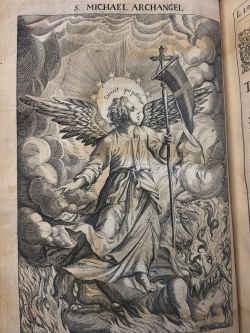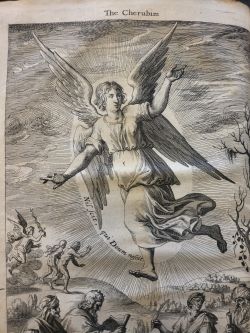The hierarchie of the blessed angells: their names, order and offices: the fall of Lucifer with his angels

The hierarchie of the blessed angells: their names, order and offices: the fall of Lucifer with his angells is a 1635 didactic poem in nine books, a complete copy of which is at the University of Pennsylvania's Kislak Center for Special Collections, Rare Books and Manuscripts. The contents, as per the name, of the collection are concerned with the categorization of angels, or angelology, in the Christian sense, as well as the rebellion of Satan and his subsequent fall of grace, along with his demons. The author is named to be Thomas Heywood, while the printer is referred to as Adam Islip. It was printed in London and dedicated to the queen at the time: Queen Henretta Maria.
History
Thomas Heywood was a early 17th century playwright, better known for his dramatic work. His later plays, however, were criticized for being too mean and taking too much from the ancients, such as Homer.[1] Little is known of Heywood's motivations for composing this 9-book didactic poem, but a dedication following the title page expresses that the collection was composed for Queen Henretta Maria, a Roman Catholic, which made her unpopular in England and prevented her from ever being crowned[2]. Given Heywood's lack of other didactic poetry, it's possible this was a commission someone may have paid him for. Noticeably, The hierarchie of the blessed angells: their names, order and offices: the fall of Lucifer with his angells appears to be his only entirely theological work. Though this book never reached the prominence of many other angelology books, it's thought to have influenced John Milton's interpretation of angels in Paradise Lost [3].

Content
Heywood used Dionysian theory as the framework from which he'd give his own interpretation of angels [4]. This theory refers to that derived from the work Dionysius, or Pseudo-Dionysius, who wrote the 5th century work De Coelesti Hierarchia. This theory was deeply influential to other major works of Christian theology, such as the Summa Theologica . Not unlike these other works, Heywood used the Ptolemaic system as the rule by which to connect the angel hierarchies to the system of the world; according to it, the universe hung by a golden chain from the Throne of God, with the universe itself being spheres within spheres until it reached the smallest one –– Earth [4]. The belief in the Ptolemaic system was no longer popular by Heywood's time, but its use in theology remained [4]. Heywood also follows St. Augustine by implying the polytheistic gods of other and their pre-Christianization past as not senseless idols, but demons tricking humans to worship them. It's remarked that at first sight of an angel, a man will first be afraid, but an angel will reassure him. A demon, on the other hand, will first make a flattering appearance, then leave the man having terrified him.
Books
- The Seraphim
- According to Heywood, the Cherubim govern the fixed stars, and their leader is Jophiel. Notably, Heywood writes, on page 283: God is and absolute Monarch; and next to Him,/ Daniel doth place the holy Cheurbim/. It's unknown if this is an error or if Heywood meant to imply that the cherubim also stand beside God, which is typically associated with the seraphim [5].
- The Dominations
- The Domination govern Jupiter, and their leader is Zadkiel.
- The Virtues
- The Virtues govern Mars, and their leader is Haniel.
- The Powers
- The Powers govern the Sun, and their leader is Raphael.
- The Principats
- The principats govern Venus, and their leader is Camael.
- The Arch-Angells
- The arch-angels govern Mercury, and their leader is Michael.

- The Angell
- The angels govern the Earth, and their leader is Gabriel.
Materiality
Physical Attributes
This rectangular book comes in brown leather binding, with five raised bands, and a broken spine. It's in a codex format, typical of its time. The cover, which is a board wrapped in leather, comes off completely. The book's pages are constructed from laid paper, known from their thinness and the chain line markings that are revealed when held up to the light. There's minor evidence of water damage, though the pages are stiff.
The print is black ink The illustrations, which every book in the collection begins with, are woodcut.
For navigation, there’s a section in the last dozen of the 600 pages, titled “A generall Table." It appears to serve as an index of name and topics along with the page number that corresponds with discussion of this. There are margins all throughout, as well, summarizing what a paragraph or a series of paragraphs are about. The collection, further, is split into sections, each its own "book". Each begins with a page that holds an angelic illustration on the lefthand side, along with a caption that states the hierarchy of the angel and section alike. There is also a short, separated poem labeled "The Argument" to begin each book. All of these "arguments" are put together at the beginning, before the first book on the seraphim, but after the title page and dedication. The argument comes labeled with the leader of each hierarchy.
-
Spine
-
Laid Paper Lines
-
Arguments Section
Use
The copy at the University of Pennsylvania has been excessively written, nearly all in what appears to be pencil, including text on the marginalia and between lines of text. Pieces of plain white paper that have either been attached, whether by tape or glue, or are loose are written in ink. Previous ownership is ascribed to Horace Howard Furness Jr., son of Horace Howard Furness, who was an influential Shakespearean scholar. His son having lived in the early 20th century; it's reasonable to assume this is when the markings were done on the collection. By virtue of all the writings, it's also reasonable to say it was probably studied very rigorously.
There's additionally small loose leaf of paper where a circle had been sketched with astrological symbols and some Hebrew along the circumference. There's writing both inside and outside the sphere.
-
Extensive writing on pages
-
Attached pages
-
Taped piece
-
Loose leaf
Notes
- ↑ Wright, Louis B. “Notes on Thomas Heywood’s Later Reputation.” The Review of English Studies 4, no. 14 (1928): 135–44. http://www.jstor.org/stable/508142
- ↑ https://www.englishmonarchs.co.uk/stuart_16.html.
- ↑ X West, Robert H. “The Names of Milton’s Angels.” Studies in Philology 47, no. 2 (1950): 211–23. http://www.jstor.org/stable/4172929.
- ↑ 4.0 4.1 4.2 Briggs, K. M. “Heywood’s Hierarchie of the Blessed Angells.” Folklore 80, no. 2 (1969): 89–106. http://www.jstor.org/stable/1258462.
- ↑ Morris, Harry. “Some Uses of Angel Iconography in English Literature.” Comparative Literature 10, no. 1 (1958): 36–44. https://doi.org/10.2307/1768503.







